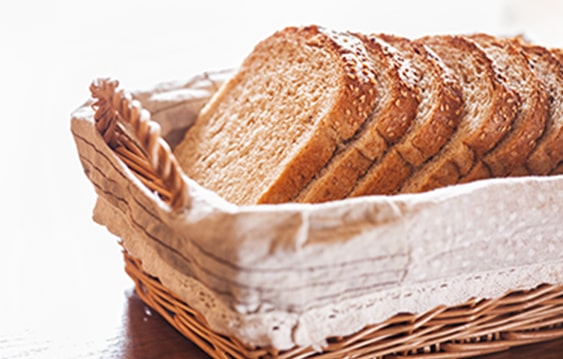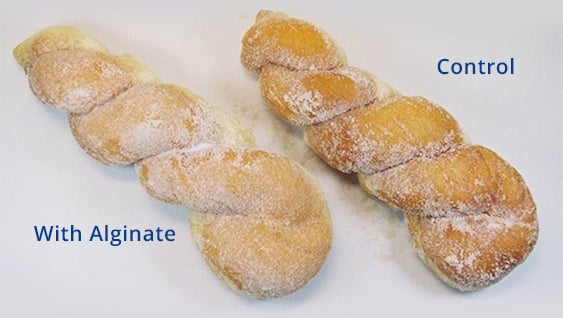Low Carbohydrate, Gluten-Free and Dietary Fiber
In recent years, the demand for new processed foods that are health-friendly to consumers has increased. Alginate is attracting attention as an improving agent in the processing and texture of these foods and as a material that provides excellent health functionality.
Applications and effects
※Alginic acid and all products derived from it are collectively called Alginate. Please refer to the correct product name for each application.

Low carbohydrate
Delicious bread and noodles can be made without using wheat flour.
![]()
![]()

Low carbohydrate has become a trend and attempts to make bread and noodles from grain flour other than wheat flour are becoming more popular. However, it is difficult to make bread and noodles without the use of wheat and to match the original taste and texture, making it difficult to develop products that can be produced and consumed consistently.
Alginate is widely used as an improver for wheat flour bread and noodles, but it also has excellent quality improvement effects on grains other than wheat flour.
Related page: Bakery
(Rice flour bread/low sugar bread)
Ingredients that cannot normally be molded into noodles can be processed by the ability of alginate gelling to form delicious noodles. Since heat sterilization is possible, they can be processed into products with long shelf storage.
- 【Alginate to be used】
- Propylene Glycol Alginate
- Propylene Glycol Alginate
- 【Recommended dosage】
- Bread: 0.5~1% against flour
Noodle: 0.1~0.5% against flour

Gluten free
Make delicious bread and noodles using rice flour.
![]()
![]()

Gluten-free foods are being developed for people who are not able to eat wheat due to a gluten allergy or have celiac disease. Excluding gluten from wheat-based bread and noodles deteriorates the taste and shape, similar to low-carbohydrated foods. Alginate has also been shown to improve processing and eating quality. Alginate has become an essential ingredient for the processing of noodles, especially using rice flour.
- 【Alginate to be used】
- Propylene Glycol Alginate
- Propylene Glycol Alginate
- 【Recommended dosage】
- Bread: 0.5~1% against flour
Noodle: 0.1~0.5% against flour

Dietary fiber
Improvement to bowel movements, intestinal regulation, lowering of cholesterol, inhibition of lipid absorption, inhibition of increase in blood glucose level.
![]()
![]()

Alginate is a natural dietary fiber found in seaweeds. Animal studies have confirmed that the consumption of alginate has various unique functions, including lowering blood cholesterol, inhibiting the absorption of lipids, inhibiting the increase in postprandial blood glucose levels and excreting toxic metals from the body, as well as the potential for the expected general physiological functions as dietary fiber (such as improving bowel movement and intestinal regulation).
Related page: Calcium Alginate
At present, clinical research is being conducted in multiple hospitals and research institutions and systematic data accumulation is progressing.
- 【Alginate to be used】
- Calcium Alginate
- Calcium Alginate

Low calorie
Reduce the amount of oil remaining in the donuts after frying.
![]()
![]()

Adding alginate to donut dough improves draining of the oil after frying and reduces the amount of oil remaining in the donut. In addition, adding alginate to croquette or tempura dough results in oil depletion and a marked effect on reducing calories. These applications of alginate can prevent stickiness and oil-induced deterioration of the texture, reduce the amount of oil consumed and also reduce the oil used during cooking.
- 【Alginate to be used】
- Propylene Glycol Alginate
- 【Recommended dosage】
- Adding to dough (yeast donuts, cake donuts, etc.) : 0.2%~1% against flour
Adding to dusting flour: Replace 20% of the dusting flour with alginate